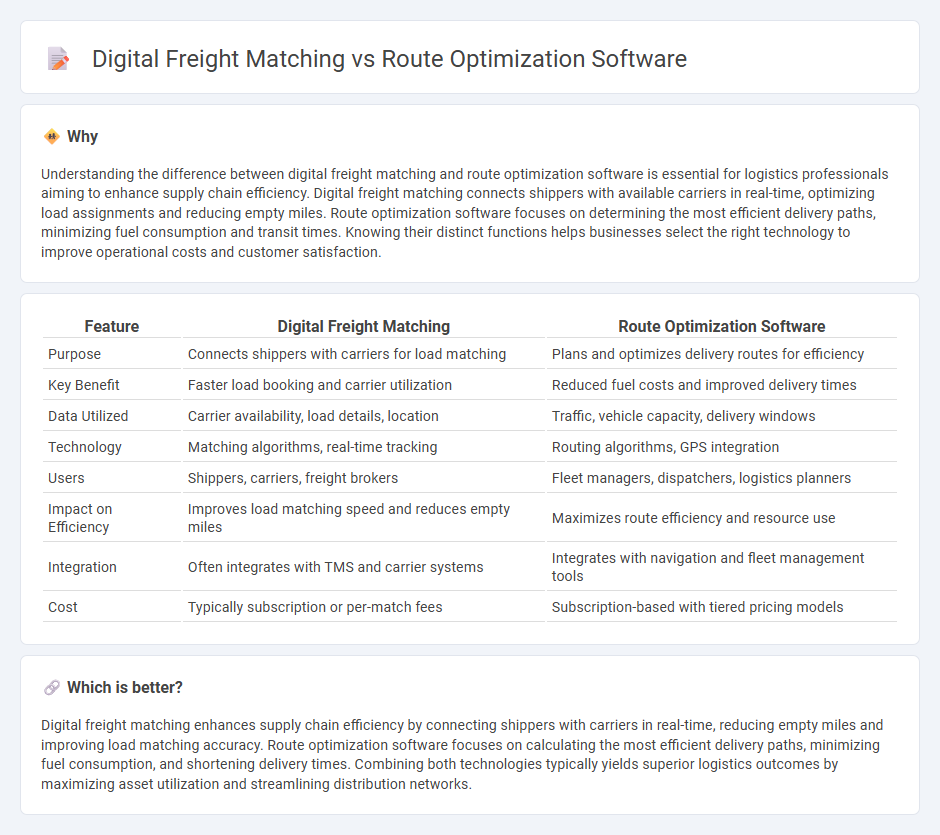
Digital freight matching streamlines cargo transport by connecting shippers with available carriers through real-time data and automated algorithms, enhancing load efficiency and reducing empty miles. Route optimization software focuses on determining the most efficient paths for multiple deliveries, minimizing fuel consumption, travel time, and operational costs. Explore how integrating these technologies can revolutionize your logistics strategy and boost overall supply chain performance.
Why it is important
Understanding the difference between digital freight matching and route optimization software is essential for logistics professionals aiming to enhance supply chain efficiency. Digital freight matching connects shippers with available carriers in real-time, optimizing load assignments and reducing empty miles. Route optimization software focuses on determining the most efficient delivery paths, minimizing fuel consumption and transit times. Knowing their distinct functions helps businesses select the right technology to improve operational costs and customer satisfaction.
Comparison Table
| Feature | Digital Freight Matching | Route Optimization Software |
|---|---|---|
| Purpose | Connects shippers with carriers for load matching | Plans and optimizes delivery routes for efficiency |
| Key Benefit | Faster load booking and carrier utilization | Reduced fuel costs and improved delivery times |
| Data Utilized | Carrier availability, load details, location | Traffic, vehicle capacity, delivery windows |
| Technology | Matching algorithms, real-time tracking | Routing algorithms, GPS integration |
| Users | Shippers, carriers, freight brokers | Fleet managers, dispatchers, logistics planners |
| Impact on Efficiency | Improves load matching speed and reduces empty miles | Maximizes route efficiency and resource use |
| Integration | Often integrates with TMS and carrier systems | Integrates with navigation and fleet management tools |
| Cost | Typically subscription or per-match fees | Subscription-based with tiered pricing models |
Which is better?
Digital freight matching enhances supply chain efficiency by connecting shippers with carriers in real-time, reducing empty miles and improving load matching accuracy. Route optimization software focuses on calculating the most efficient delivery paths, minimizing fuel consumption, and shortening delivery times. Combining both technologies typically yields superior logistics outcomes by maximizing asset utilization and streamlining distribution networks.
Connection
Digital freight matching platforms leverage route optimization software to efficiently connect shippers with carriers by analyzing real-time data on shipment locations, traffic conditions, and delivery deadlines. This integration reduces empty miles and fuel consumption, enhancing overall supply chain efficiency and cost-effectiveness. Companies using combined digital freight matching and route optimization technologies report improved fleet utilization and faster delivery times.
Key Terms
**Route Optimization Software:**
Route optimization software uses advanced algorithms and real-time data to determine the most efficient delivery routes, reducing fuel consumption, travel time, and operational costs for logistics companies. It integrates with GPS and telematics systems to dynamically adjust routes based on traffic, weather, and delivery constraints, ensuring optimal fleet utilization. Explore how route optimization software can transform your supply chain management for improved efficiency and cost savings.
Algorithm
Route optimization software leverages advanced algorithms such as genetic algorithms, Dijkstra's, or linear programming to determine the most efficient paths for multiple stops, minimizing travel time and fuel consumption. Digital freight matching platforms employ real-time data-driven algorithms that analyze truck availability, load requirements, and geographic proximity to instantly connect shippers with carriers, optimizing freight loads dynamically. Explore more advantages and technical distinctions between these algorithms to enhance logistics efficiency and decision-making.
Geocoding
Route optimization software leverages advanced geocoding to convert addresses into precise geographic coordinates, enabling efficient routing and reduced travel time. Digital freight matching platforms use geocoding to accurately pinpoint shipment origins and destinations, facilitating real-time load matching between carriers and shippers. Explore how geocoding enhances logistics efficiency by delving deeper into route optimization and digital freight matching technologies.
Source and External Links
Top 10 Route Optimization Software in 2025 - Upper offers advanced route optimization focusing on driver-friendly routes, real-time adjustments, dynamic traffic integration, and mobile app excellence with offline access and voice-to-text notes, improving delivery efficiency and driver satisfaction significantly.
RouteXL - fastest route with multiple stops - RouteXL is an online route planner ideal for multiple stops, saving time, money, and fuel, free for up to 20 addresses, and widely used by couriers, salesmen, and logistics personnel for optimal itinerary planning.
Best Route Planning And Route Optimization Software - Route4Me automates last mile workflows with enterprise-grade route optimization, enabling route planners, dispatchers, and drivers to improve efficiency through features like real-time dispatch, tracking, and detailed business insights.
 dowidth.com
dowidth.com